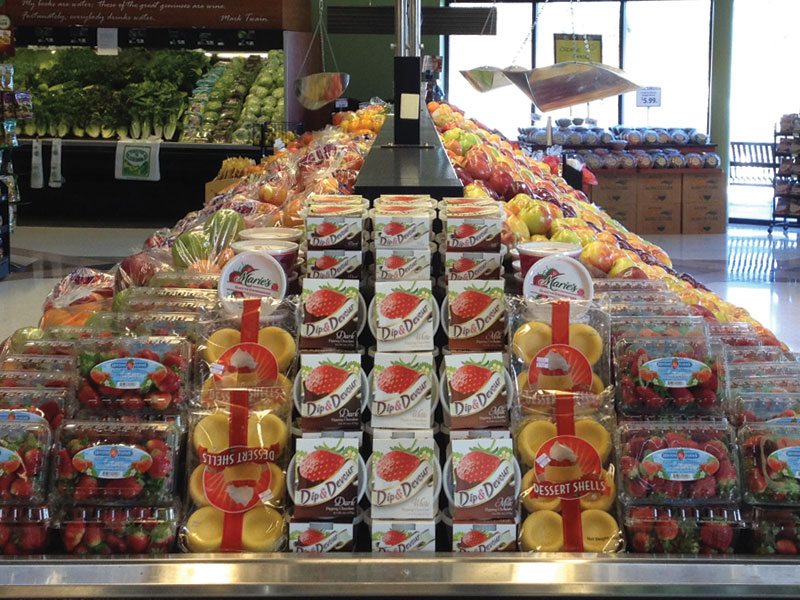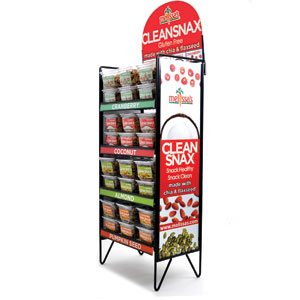The Art of Tying In
June 1, 2016 | 7 min to read
Fresh approaches to companion products for fruit are revitalizing supermarket sales, with tie-ins like dressings and dips boosting impulse buys. As consumer preferences evolve, items like Clean Snax and Dip & Devour are gaining popularity. Promotions and effective displays remain crucial for driving sales. Additionally, companies like Lighthouse Foods leverage samplings to encourage consumers to explore new flavors. Despite their potential, pairings of cheese and fruit often remain underutilized in produce sections due to traditional departmental divisions.

Fresh approaches to companion products for fruit often yield double rings.
Produce sales tie-ins are not exactly a new idea. Historians report merchants in marketplaces sold fruit right next to nuts, bread and other favorites to grab the ancient equivalent of a double-ring from customers.
The question isn’t whether tie-ins help sell more fresh fruit — they clearly can — but whether there are larger co-marketing opportunities out there because of evolving demographics.
Supermarkets are using quality fresh produce to differentiate themselves in a crowded marketplace as consumers continue the quest for cooking solutions, convenience and “free-from” formulations anybody in the family can eat.
 Whether referred to as “companion products,” “complementary products,” or “tie-ins,” non-produce PLUs can include dressings, caramel dips, pie shells, shortcakes, crepes, angel food cakes, glazes, and chocolate, yogurt or cheese dips. Proximity still rules, like keeping the caramel dip next to the Granny Smith apples, but location can matter more, say experts. Seasonal free-standing displays are more likely to catch the attention of shoppers, especially regulars who follow a familiar, rapid route through the store. Placing strawberries next to glaze, shortcake, sponge cakes and canned whipped cream — where shoppers encounter it face-on — invites an impulse buy.
Whether referred to as “companion products,” “complementary products,” or “tie-ins,” non-produce PLUs can include dressings, caramel dips, pie shells, shortcakes, crepes, angel food cakes, glazes, and chocolate, yogurt or cheese dips. Proximity still rules, like keeping the caramel dip next to the Granny Smith apples, but location can matter more, say experts. Seasonal free-standing displays are more likely to catch the attention of shoppers, especially regulars who follow a familiar, rapid route through the store. Placing strawberries next to glaze, shortcake, sponge cakes and canned whipped cream — where shoppers encounter it face-on — invites an impulse buy.
The fruit companion product tent has expanded in number and types of products in the past decade to feature banana bread and other mixes, smoothie mixes, and a wide range of good-for-you snacks formerly seen mainly in the natural foods stores. Companies are introducing new companion products from snacks to dips as well as fresh display and marketing approaches.
Healthier Dessert Options
Melissa’s/World Variety Produce has had long-term success with tie-ins including crepes, an item which have been on produce department shelves for 25 years. “Tie-ins increase sales in the produce department or they wouldn’t be there. Retailers have reported to us 10 percent to 20 percent increases in sales in the berry category and higher during promotions with tie-ins,” says Robert Schueller, director of public relations at the Los Angeles-based distributor of specialty produce and companion products.
Schueller ticked off the reasons tie-ins are attractive including guaranteed sales, typically a much higher markup than fruit, and much less perishable. However, not all tie-ins have the durability of Melissa’s crepes. “There have been some companion products that have just fizzled after a while. One is those vegetable washing sprays that became popular after a produce safety issue came up. Consumers realized they didn’t really need the spray to clean their produce,” he says.
However, overall health concerns are driving consumers toward fresh fruit. “Crepes and sauce displayed next to the berries are perceived as a lighter, healthier option than a lot of other desserts,” he says.
Melissa’s introduced a new kind of companion product called Clean Snax three years ago. The shelf-stable, bite-sized squares of chia and flaxseed are lightly sweetened with honey. They are also gluten-free, low-fat, low-sodium and contain no artificial ingredients. “This is the third year we are carrying Clean Snax and they have only gotten more popular. We just added a fifth flavor, cranberry, to go with the coconut, pepitas, quinoa and almond flavors,” says Schueller.
“Clean Snax are not placed in the granola or snack bar supermarket aisle even though the ingredients are similar. Granola is no longer seen by consumers as being really healthy.”
A lot of new products are vying for attention in the produce department where retail produce executives are naturally possessive about their floor and shelf space and devoting it to slower selling non-produce items.
Producing A Double Ring
Tropical Foods, a manufacturer and packer of roasted nuts and dried fruits, started out as a bulk foods distributor. Today it supplies major supermarket chains. “We have a tub program for supermarkets where we put in snacks, nuts, seeds, dried fruit and candy,” says Chad Hartman, director of marketing of the Charlotte, NC-based company.
“Crepes and sauce displayed next to the berries are perceived as a lighter, healthier option than a lot of other desserts.”
— Robert Schueller, Melissa’s/World Variety Produce
Tropical’s items include everything from wasabi-coated peanuts to probiotic yogurt raisins and goji berries, but one of the fastest selling item is Dip & Devour, a line of chocolate-flavored coatings in milk, dark and white in resealable, microwavable containers.
Like similar meltable dips, the product is typically pictured with strawberries or bananas, but consumers also dip in dried fruit. “My favorite fruit to dip in the milk Dip & Devour is dried pineapple; apricots are great, too,” says Hartman. The newest addition to the Dip & Devour line is peanut butter melts for celery, apples or bananas (and perhaps an occasional cookie).
“The peanut butter Dip & Devour has been a much tougher sell because it’s new and unfamiliar, but anytime we can do an active demo program with a microwave in stores it sells all day long,” he says. Hartman says sampling tends to happen at store grand openings or customer appreciation days. “In terms of promotion, the thing that drives customers to the fruit the most is an IPR (item price reduction) on the shelf and in-store signage.”
Digital and mobile advertising has become essential in reaching younger consumers. “What we try to do is show the product and how easy it is to use in videos, Instagram and Twitter,” says Hartman.
He has seen displays with two rows of strawberries in clamshells with a row of Dip & Devour up the middle, but one store’s approach caught his eye: “The most effective marketing I’ve seen was strawberries and Dip & Devour wrapped in the same package by one retailer. The double ring is automatic,” he says. The least effective approach? “The moment they put it under the end table near the potatoes, it’s over. It stops selling,” says Hartman.
Expanding Palate, New Flavors
“The American palate is expanding to include more exotic fruits and ethnic tastes,” says Margi Gunter, brand manager at Litehouse Foods. The Sandpoint, ID-based makers of refrigerated dressings, dessert dips and crumbled Blue, Gorgonzola and Feta cheeses recently launched OPA Greek yogurt dressings in the pourable format in five flavors including curry and strawberry poppy seed. “With new pairings, like fruit with a savory dressing like our OPA curry Greek yogurt dressing, the key is to have the consumer taste it. Curry is a flavor that can be kind of scary but this is very mild and goes so well with tropical fruits like mango,” she says.
In order to support effective sampling, Lighthouse ships demo kits to the demo companies. “Even if we aren’t partnering with a produce company we always have the demo company buy their fruit from the store,” says Gunter. “We had the greatest consumer reaction to demos by just hulling fresh strawberries and putting a dollop of Opadipity Creamy Cheesecake or Vanilla Almond in the center. Consumers could see the easy two-step process and kids were clamoring for more. Moms were quick to comply because who wouldn’t give their child more fruit?”
She isn’t kidding — Gunter has 5-year-old triplets. “When I pack lunches I give them cut fresh fruit with a light coating of strawberry poppy seed dressing. They really like it.”
Lighthouse co-promotes its dips and dressings with fruit on sale in the produce department. “By purchasing our product, consumers can get $1 off their bananas or strawberries. It incentivizes them to try our product and get discounts on produce they already buy. Consumers who try the product tend to become repeat buyers,” she says.
Smoothie Mix A Stealth Seller
“The American palate is expanding to include more exotic fruits and ethnic tastes,” says Margi Gunter, brand manager at Litehouse Foods. The Sandpoint, ID-based makers of refrigerated dressings, dessert dips and crumbled Blue, Gorgonzola and Feta cheeses recently launched OPA Greek yogurt dressings in the pourable format in five flavors including curry and strawberry poppy seed. “With new pairings, like fruit with a savory dressing like our OPA curry Greek yogurt dressing, the key is to have the consumer taste it. Curry is a flavor that can be kind of scary but this is very mild and goes so well with tropical fruits like mango,” she says.
In order to support effective sampling, Lighthouse ships demo kits to the demo companies. “Even if we aren’t partnering with a produce company we always have the demo company buy their fruit from the store,” says Gunter. “We had the greatest consumer reaction to demos by just hulling fresh strawberries and putting a dollop of Opadipity Creamy Cheesecake or Vanilla Almond in the center. Consumers could see the easy two-step process and kids were clamoring for more. Moms were quick to comply because who wouldn’t give their child more fruit?”
She isn’t kidding — Gunter has 5-year-old triplets. “When I pack lunches I give them cut fresh fruit with a light coating of strawberry poppy seed dressing. They really like it.”
Lighthouse co-promotes its dips and dressings with fruit on sale in the produce department. “By purchasing our product, consumers can get $1 off their bananas or strawberries. It incentivizes them to try our product and get discounts on produce they already buy. Consumers who try the product tend to become repeat buyers,” she says.
Getting Cheese And Fruit Together
You see apples served with Cheddar on cheese plates. Strawberries are often paired with Mascarpone cheese on restaurant menus. Goat milk Chevre is often sampled with peaches at farmers markets.But look in the typical supermarket produce department and you probably won’t see a triple crème cheese displayed next to raspberries or fresh figs or smoked Gouda nestled by the Cotton Candy grapes. Cheese, deli and prepared foods departments are often adjacent to produce sections. Sometimes the cheeses and grapes are only a few yards apart.According to Sue Merckx, director of marketing for Plymouth WI-based Sartori Food, it’s a matter of tradition and supermarket department separation. When the company does tastings at the corporate offices, “we always incorporate fruit on the cutting board with our cheeses,” she says.
The website for Sartori Cheeses suggests matching the company’s aged SarVecchio Parmesan with red grapes or dried pineapple and Dolce Gorgonzola with figs, pears and red grapes.
Since everyone — including consumers — agrees cheese and fruit are wonderful together, why are they seldom displayed as tie-ins? “We work with deli departments. We never work with produce departments. It’s because they are two different management offices,” she says. Sartori does partner with Salad Girl organic dressings for in-store demos featuring vegetable and cheese skewers … but not fruit.
13 of 25 article in Produce Business June 2016

